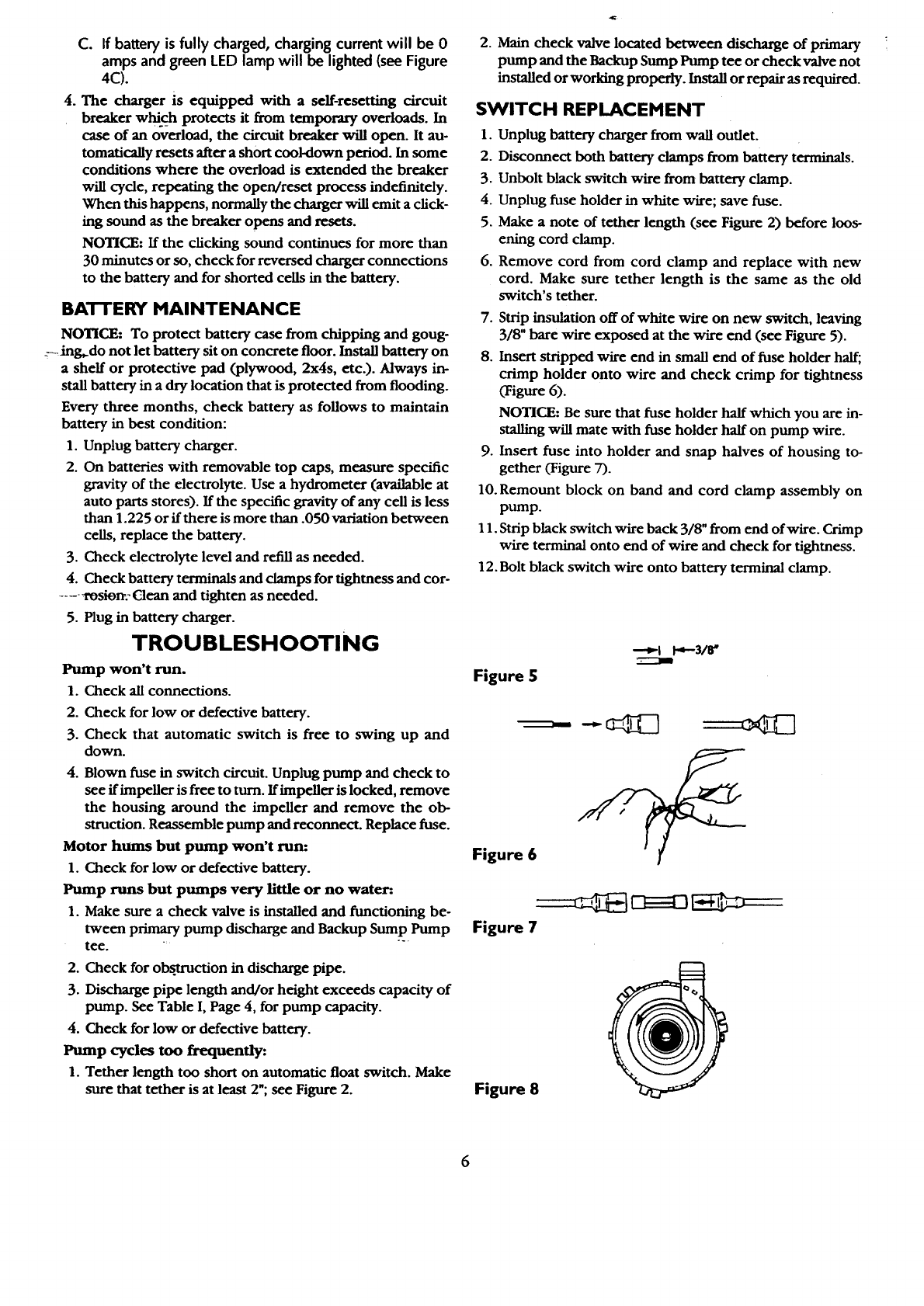
C. If battery is fully charged, charging current will be 0
amps and green LED lamp will be lighted (see Figure
4C).
4. The charger is equipped with a self-resetting circuit
breaker whi_ch protects it from temporary overloads. In
case of an overload, the circuit breaker will open. It au-
tomatically resets after a short cool-down period. In some
conditions where the overload is extended the breaker
will cycle, repeating the open/reset process indefinitely.
When this happens, normally the charger will emit a click-
ing sound as the breaker opens and resets.
NOTICE: If the clicking sound continues for more than
30 minutes or so, check for reversed charger connections
to the battery and for shorted cells in the battery.
BATTERY MAINTENANCE
NOTICE: To protect battery case from chipping and goug-
:--ing,.do not let battery sit on concrete floor. Install battery on
a shell or protective pad (plywood, 2x4s, etc.). Always irv
stall battery in a dry location that is protected from flooding.
Every three months, check battery as follows to maintain
battery in best condition:
1. Unplug battery charger.
2. On batteries with removable top caps, measure specific
gravity of the electrolyte. Use a hydrometer (available at
auto parts stores). If the specific gravity of any cell is less
than 1.225 or if there is more than .050 variation between
cells, replace the battery.
3. Check electrolyte level and refill as needed.
4. Check battery terminals and clamps for tightness and cor-
.... _rosion_: Clean and tighten as needed.
5. Plug in battery charger.
TROUBLESHOOTING
Pump won't run.
1. Check all connections.
2. Check for low or defective battery.
3. Check that automatic switch is free to swing up and
down.
4. Blown fuse in switch circuit. Unplug pump and check to
see if impeller is free to turn. If impeller is locked, remove
the housing around the impeller and remove the ob-
struction. Reassemble pump and reconnect. Replace fuse.
Motor hums but pump won't run:
1. Check for low or defective battery.
Pump runs but pumps very little or no water:
1. Make sure a check valve is installed and functioning be-
tween primary pump discharge and Backup Sump Pump
tee. ".....
2. Check for obstruction in discharge pipe.
3. Discharge pipe length and/or height exceeds capacity of
pump. See Table I, Page 4, for pump capacity.
4. Check for low or defective battery.
Pump cycles too frequently:
1. Tether length too short on automatic float switch. Make
sure that tether is at least 2n; see Figure 2.
2. Main check valve located between discharge of primary
pump and the Backup Sump Pump tee or check valve not
installed or working properly. Install or repair as required.
SWITCH REPLACEMENT
1. Unplug battery charger from wall outlet.
2. Disconnect both battery clamps from battery terminals.
3. Unbolt black switch wire from battery clamp.
4. Unplug fuse holder in white wire; save fuse.
5. Make a note of tether length (see Figure 2) before loos-
ening cord clamp.
6. Remove cord from cord clamp and replace with new
cord. Make sure tether length is the same as the old
switch's tether.
7. Strip insulation off of white wire on new switch, leaving
3/8" bare wire exposed at the wire end (see Figure 5).
8. Insert stripped wire end in small end of fuse holder half;
crimp holder onto wire and check crimp for tightness
(Figure 6).
NOTICE: Be sure that fuse holder half which you are in-
stalling will mate with fuse holder half on pump wire.
9. Insert fuse into holder and snap halves of housing to-
gether (Figure 7).
10. Remount block on band and cord clamp assembly on
pump.
11. Strip black switch wire back 3/8" from end of wire. Crimp
wire terminal onto end of wire and check for tightness.
12. Bolt black switch wire onto battery terminal clamp.
Figure 5
--'_t t-_--3/8"
Figure 6
Figure 7
Figure 8
6










